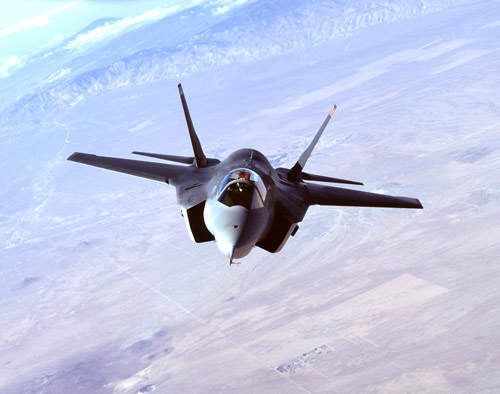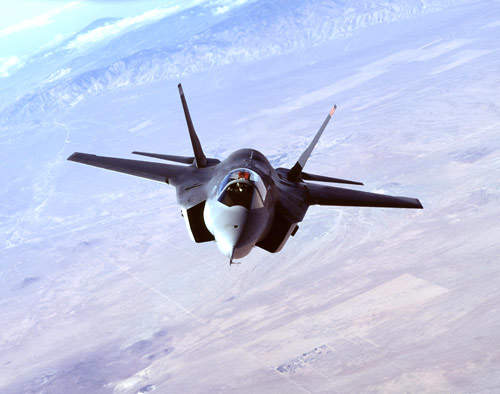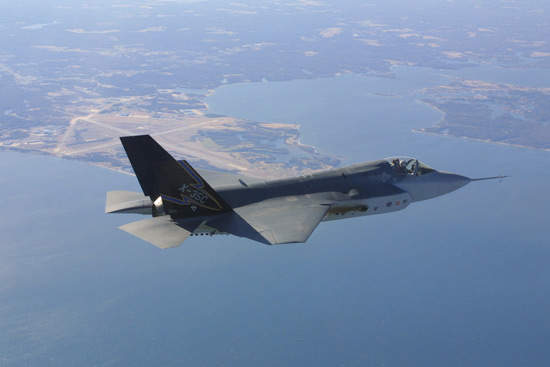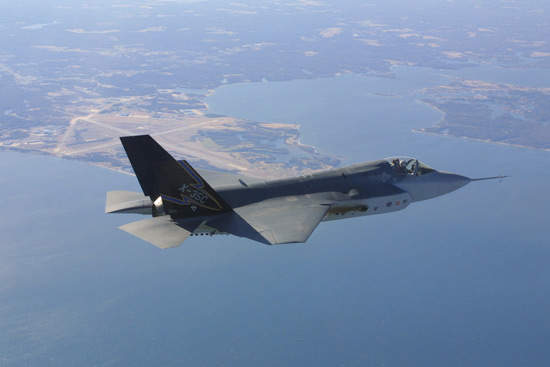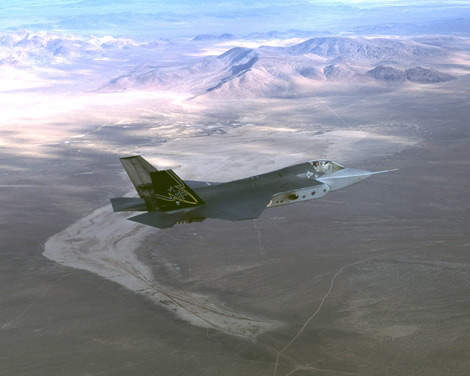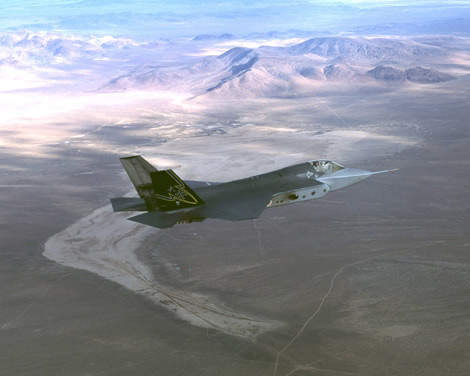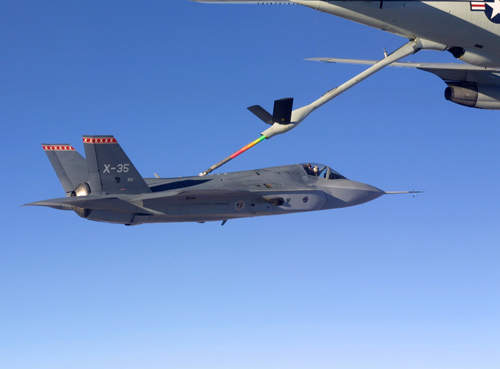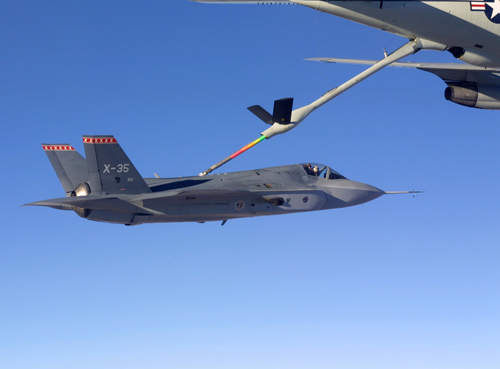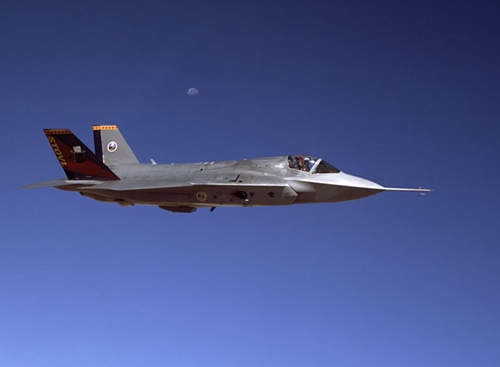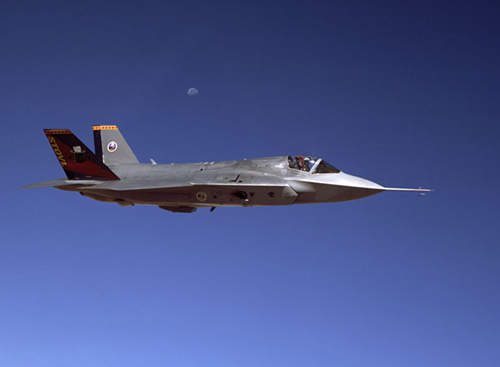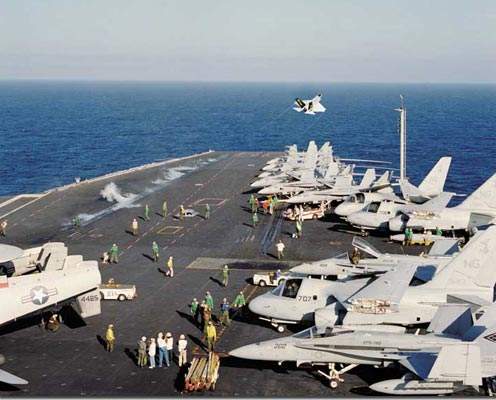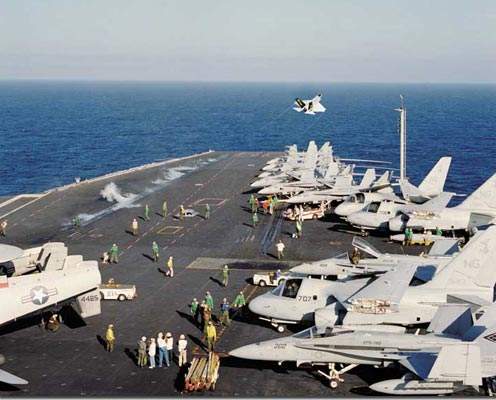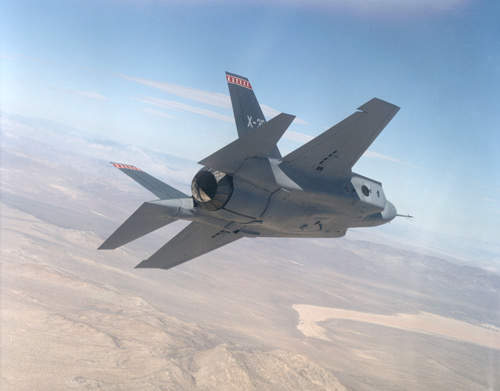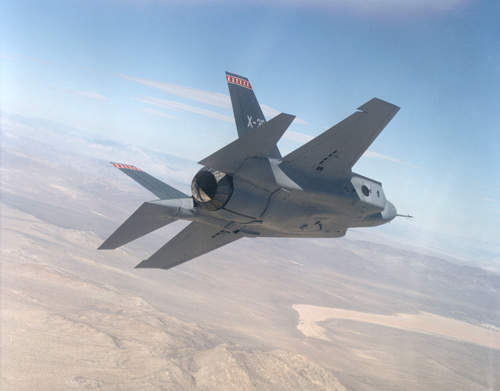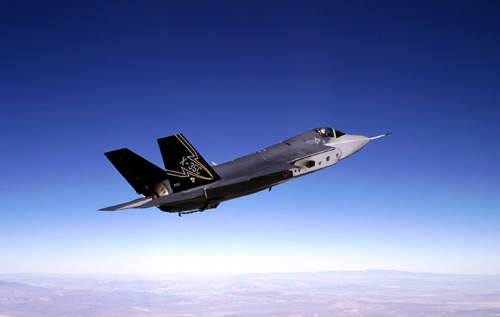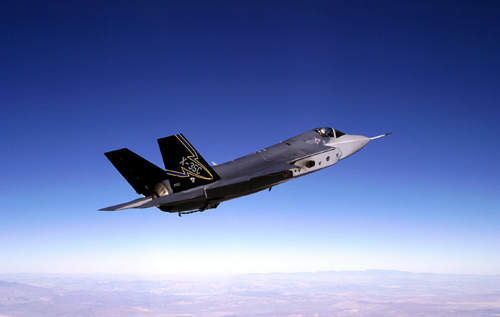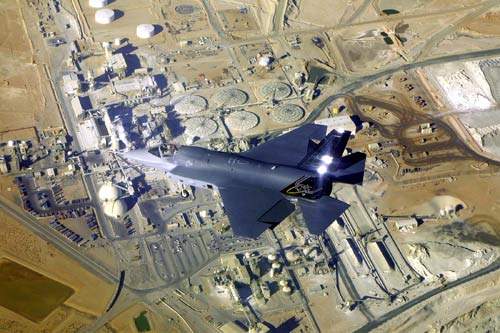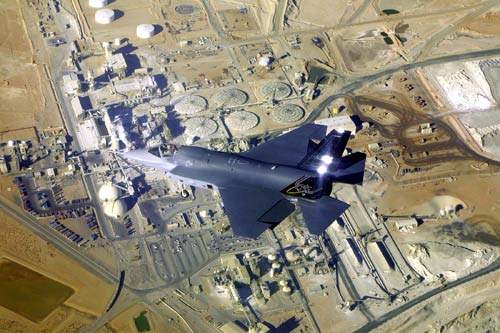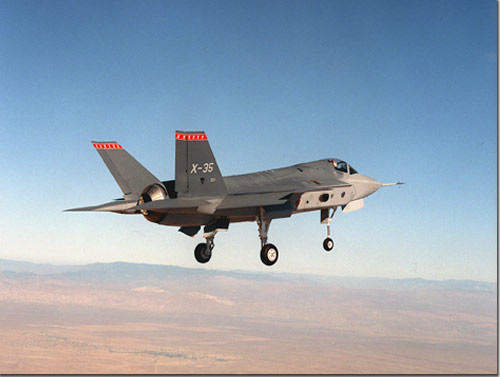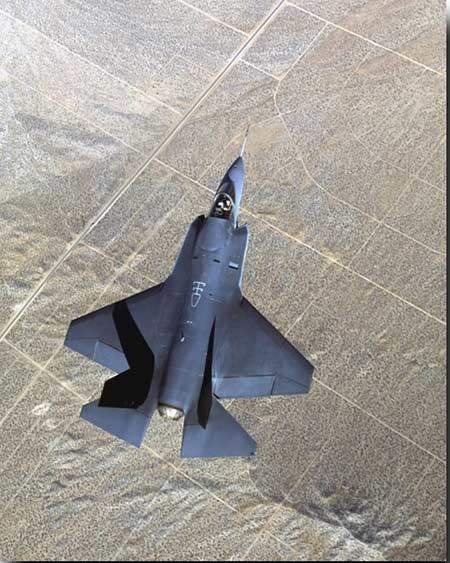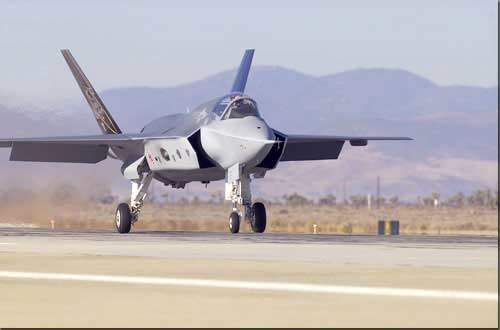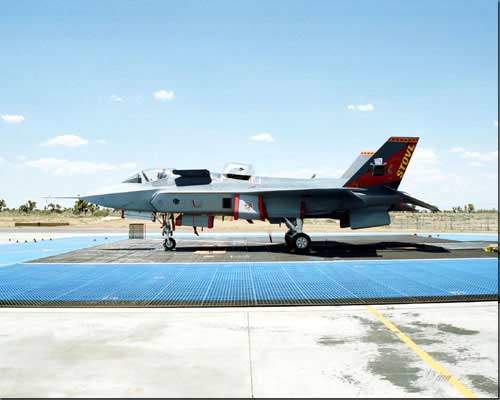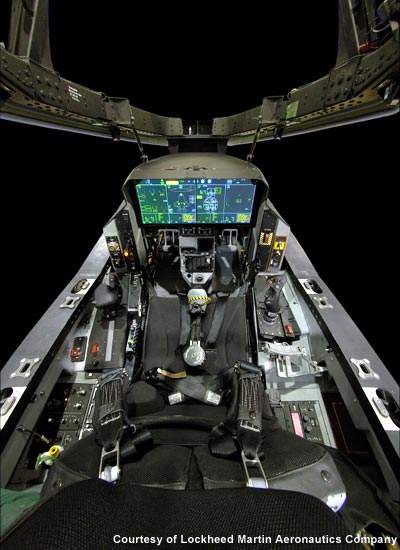The F-35 Lightning II joint strike fighter (JSF), is being developed by Lockheed Martin Aeronautics Company for the US Air Force, Navy and Marine Corps and the UK Royal Navy.
The stealthy, supersonic multirole fighter was designated the F-35 Lightning II in July 2006. The JSF is being built in three variants: a conventional take-off and landing aircraft (CTOL) for the US Air Force; a carrier variant (CV) for the US Navy; and a short take-off and vertical landing (STOVL) aircraft for the US Marine Corps and the Royal Navy. A 70%-90% commonality is required for all variants.
F-35 Joint Strike Fighter carrier variants
 F-35B Joint Strike Fighter STOVL
F-35B Joint Strike Fighter STOVL
The F-35B Standard Take-off and Vertical Landing (STOVL) is a single-engine, fifth generation fighter aircraft designed and developed by Lockheed Martin.
 F-35C Joint Strike Fighter CATOBAR
F-35C Joint Strike Fighter CATOBAR
The F-35C CATOBAR (Catapult Assisted Take Off Barrier Arrested Recovery) is the fifth generation fighter carrier variant and will be the first stealth bomber aircraft in the US Navy.
F-35 Joint Strike Fighter programme
The Joint Strike Fighter requirements are for: USAF F-35A air-to-ground strike aircraft, replacing F-16 and A-10, complementing F-22 (1763); USMC F-35B – STOVL strike fighter to replace F/A-18B/C and AV-8B (480); UK RN F-35C – STOVL strike fighter to replace Sea Harriers (60); US Navy F-35C – first-day-of-war strike fighter to replace F/A-18B/C and A-6, complementing the F/A-18E/F (480 aircraft).
In January 2001, the UK MoD signed a memorandum of understanding to co-operate in the SDD (system development and demonstration) phase of JSF and, in September 2002, selected the STOVL variant to fulfil the future joint combat aircraft (FJCA) requirement. Following the contract award, other nations signed up to the SDD phase are: Australia, Canada, Denmark, Italy, Netherlands, Norway, Singapore and Turkey.
The development of the centre fuselage for the first international F-35 joint strike fighter began on 30 October 2009. It is being developed by Northrop Grumman, principally for the UK. The centre fuselage including composite air inlet ducts were supplied by Turkish Aerospace Industries (TAI).
The F-35B short take-off and vertical landing (STOVL) variant, designated BK-1, is being developed as part of the low-rate initial production (LRIP) 3 and is expected to produce 138 F-35Bs for the UK.
F-35 Joint Strike Fighter design
In order to minimise the structural weight and complexity of assembly, the wingbox section integrates the wing and fuselage section into one piece. To minimise radar signature, sweep angles are identical for the leading and trailing edges of the wing and tail (planform alignment).
The fuselage and canopy have sloping sides. The seam of the canopy and the weapon bay doors are sawtoothed and the vertical tails are canted at an angle.
The marine variant of JSF is very similar to the air force variant, but with a slightly shorter range because some of the space used for fuel is used for the lift fan of the STOVL propulsion system.
The main differences between the naval variant and the other versions of JSF are associated with the carrier operations. The internal structure of the naval version is very strong to withstand the high loading of catapult-assisted launches and tailhook arrested landings.
The aircraft has larger wing and tail control surfaces for low-speed approaches for carrier landing. Larger leading edge flaps and foldable wingtip sections provide a larger wing area, which provides an increased range and payload capacity.
The canopy (supplied by GKN Aerospace), radar and most of the avionics are common to the three variants.
The centre fuselage assembling process includes loading of an all-composite air inlet duct into a special tooling structure called a jig, followed by 18 major steps such as bonding metal frames around the duct. The frames serve to brace and position the duct properly within the centre fuselage.
Cockpit and avionics systems
L-3 Display Systems is developing the panoramic cockpit display system, which will include two 10in×8in active matrix liquid crystal displays and display management computer.
The following will also supply F-35 avionics systems:
- BAE Systems Avionics – side stick and throttle controls
- Vision Systems International (a partnership between Kaiser Electronics and Elbit of Israel) – advanced helmet-mounted display
- BAE Systems Platform Solutions – alternative design helmet-mounted display, based on the binocular helmet being developed for the Eurofighter Typhoon
- Ball Aerospace – communications, navigation and integration (CNI) integrated body antenna suite (one S-band, two UHF, two radar altimeter, three L-band antennas in each aircraft)
- Harris Corporation – advanced avionics systems, infrastructure, image processing, digital map software, fibre optics, high-speed communications links and part of the communications, navigation and information (CNI) system
- Honeywell – radar altimeter, inertial navigation / global positioning system (INS/GPS) and air data transducers
- Raytheon – 24-channel GPS with digital anti-jam receiver (DAR).
Weapons
Weapons are carried in two parallel bays located in front of the landing gear. Each weapons bay is fitted with two hardpoints for carrying a range of bombs and missiles.
Weapons to be cleared for internal carriage include: JDAM (joint direct attack munition), CBU-105 WCMD (wind-corrected munitions dispenser) for the sensor-fused weapon, JSOW (joint stand-off weapon), Paveway IV guided bombs, small diameter bomb (SDB), AIM-120C AMRAAM air-to-air missile and Brimstone anti-armour missile; for external carriage: JASSM (joint air-to-surface stand-off missile), AIM-9X Sidewinder, AIM-132 ASRAAM and Storm Shadow cruise missile.
In September 2002, General Dynamics Armament and Technical Products was selected as the gun system integrator. General Dynamics was awarded a contract for the internally mounted 25mm GAU-22/A gun system for the air force CTOL variant in November 2008. General Dynamics is developing an external gun system for the carrier and marine variants.
Targeting
Lockheed Martin Missile & Fire Control and Northrop Grumman Electronic Sensors and Systems are jointly responsible for the JSF electro-optical system. A Lockheed Martin electro-optical targeting system (EOTS) will provide long-range detection and precision targeting, along with the Northrop Grumman DAS (distributed aperture system) thermal imaging system.
EOTS will be based on the Sniper XL pod developed for the F-16, which incorporates a mid-wave third-generation FLIR, dual mode laser, CCD TV, laser tracker and laser marker. BAE Systems Avionics in Edinburgh, Scotland will provide the laser systems.
DAS consists of multiple infrared cameras (supplied by Indigo Systems of Goleta, California) providing 360° coverage using advanced signal conditioning algorithms. As well as situational awareness, DAS provides navigation, missile warning and infrared search and track (IRST). EOTS is embedded under the aircraft’s nose, and DAS sensors are fitted at multiple locations on the aircraft.
Radar
Northrop Grumman Electronic Systems is developing the advanced electronically scanned array (AESA) AN/APG-81 multi-function radar. The AN/APG-81AESA will combine an integrated radio frequency subsystem with a multifunction array.
The radar system will also incorporate the agile beam steering capabilities developed for the APG-77. Northrop Grumman delivered the first radar to Lockheed Martin in March 2005 for flight testing.
Countermeasures
BAE Systems Information & electronic warfare systems (IEWS) will be responsible for the JSF integrated electronic warfare suite, which will be installed internally and have some subsystems from Northrop Grumman. BAE is developing a new digital radar warning receiver for the F-35.
Systems
Other suppliers include:
- ATK Composites – upper wing skins
- Vought Aircraft Industries – lower wing skins
- Smiths Aerospace – electronic control systems, electrical power system (with Hamilton Sundstrand), integrated canopy frame
- Honeywell – landing system wheels and brakes, onboard oxygen-generating system (OBOGS), engine components, power and thermal management system driven by integrated auxiliary power unit (APU)
- Parker Aerospace – fuel system, hydraulics for lift fan, engine controls and accessories
- Moog Inc – primary flight control electrohydrostatic actuation system (EHAS), leading edge flap drive system and wing-fold system
- EDO Corporation – pneumatic weapon delivery system
- Goodrich – lift-fan anti-icing system
- Stork Aerospace – electrical wiring
Propulsion
Early production lots of all three variants will be powered by the Pratt and Whitney afterburning turbofan F-135 engine, a derivative of the F119 fitted on the F-22. Following production aircraft will be powered by either the F135 or the F-136 turbofan being developed by General Electric and Rolls-Royce. However, in the 2007 US Military Budget, published in February 2006, no funding was allocated for the development of the F-136 engine. The US Congress voted to restore funding for the F-136 in October 2006.
Each engine will be fitted with two BAE Systems full authority digital electronic control (FADEC) systems. Hamilton Sundstrand is providing the gearbox.
On the F-35B, the engine is coupled with a shaft-driven lift fan system for STOVL propulsion. The counter-rotating lift fan, developed by Rolls-Royce Defence, can generate more than 20,000lb of thrust. Doors installed above and below the vertical fan open as the fin spins up to provide vertical lift.
The main engine has a three-bearing swivelling exhaust nozzle. The nozzle, which is supplemented by two roll control ducts on the inboard section of the wing, together with the vertical lift fan provide the required STOVL capability.
JSF training programme and bases
An integrated training centre for the F-35 fighter programme is to be set up at Elgin Air Force Base in the US. The training centre will be inaugurated in 2010 and will be fully operational by 2013. Initial deliveries of F-35 fighter aircraft to Elgin Air Force Base are expected in 2010.
A total of 11 base locations were unveiled for the F-35 Lightning joint strike fighter. Of the 11, six were selected to carry out operations and five to be training bases.
The six bases implementing F-35 operations are Burlington International Airport Guard Station, Vermont; Hill AFB, Utah; Jacksonville International Airport Air Guard Station, Florida; Mountain Home AFB, Idaho; Shaw AFB, South Carolina; and McEntire Air Guard Base, South Carolina. The five bases for training purposes are Boise Air Terminal Air Guard Station, Idaho; Eglin Air Force Base, Florida; Holloman Air Force Base, New Mexico; Luke AFB, Arizona; and Tucson International Airport Air Guard Station, Arizona.
JSF concept demonstration phase
The concept demonstration phase of the programme began in November 1996 with the award of contracts to two consortia, led by Boeing Aerospace and Lockheed Martin. The contracts involved the building of demonstrator aircraft for three different configurations of JSF, with one of the two consortia to be selected for the development and manufacture of all three variants.
In October 2001, an international team led by Lockheed Martin was awarded the contract to build JSF. An initial 22 aircraft (13 flying test aircraft and eight ground-test aircraft) will be built in the programme’s system development and demonstration (SDD) phase. Flight testing will be carried out at Edwards Air Force Base, California, and Naval Air Station, Patuxent River, Maryland.
In April 2003, JSF completed a successful preliminary design review (PDR). The critical design review (CDR) for the F-35A was completed in February 2006, for the F-35B in October 2006 and for the F-35C in June 2007. The first flight of the CTOL F-35A took place on 15 December 2006. Low-rate initial production (LRIP) for the F-35A/B was approved in April 2007 with an order for two CTOL aircraft. An LRIP 2 contract for six CTOL aircraft was placed in July 2007. The STOVL F-35B was rolled out in December 2007 and made its first flight, a conventional take-off and landing, in June 2008. STOVL flights began in early 2009. An LRIP contract for six F-35B STOVL aircraft was placed in July 2008.
By the end of 2006, Australia, Canada, the Netherlands and the UK had signed the MoU for the F-35 Production, Sustainment and Follow-on Development (PSFD) phase.
Norway and Turkey (requirement 100 F-35A) signed in January 2007. Denmark and Italy (requirement 131 F-35A and B) signed in February 2007. In May 2008, Israel requested the sale of 25 F-35A aircraft with 50 options.
Participating nations are to sign up to the initial operation test and evaluation (IOT&E) phase by the end of February 2009. In October 2008, Italy announced that it intended not to participate in the IOT&E.
In September 2004, Lockheed Martin announced that, following concerns over the weight of the STOVL F-35B, design changes had reduced the aircraft weight by 1,225kg while increasing propulsion efficiency and reducing drag. The weight requirements will also call for a smaller internal weapons bay than on the other variants.
Joint Strike Fighter production team
The Lockheed Martin JSF team includes Northrop Grumman, BAE Systems, Pratt and Whitney and Rolls-Royce. Final assembly of the aircraft will take place at Lockheed Martin’s Fort Worth plant in Texas.
Major subassemblies will be produced by Northrop Grumman Integrated Systems at El Segundo, California and BAE Systems at Samlesbury, Lancashire, England. BAE Systems is responsible for the design and integration of the aft fuselage, horizontal and vertical tails and the wing-fold mechanism for the CV variant, using experience from the Harrier STOVL programme. Terma of Denmark and Turkish Aerospace Industries of Turkey are supplying sub-assemblies for the centre fuselage.
F-35 orders and deliveries
Lockheed Martin had delivered nine of the 19 test aircraft by mid 2009. Deliveries of the remaining aircraft from the first production model will begin in 2010.
16 CTOL and 15 STOVL production-model aircraft are in assembly and represent the aircraft in low rate initial production (LRIP) lots 1, 2 and 3. The CTOL variant includes one Dutch aircraft, while the STOVL offering includes two UK aircraft.
The LRIP 4 will produce 32 additional aircraft. This will include four CV, 15 STOVL and 13 CTOL aircraft.
An $18.8m contract was awarded to Lockheed Martin Aeronautics by Dutch Space and Dutch National Aerospace Laboratory (NLR) to build and instal an embedded training system for the F-35 strike fighter aircraft. Multiship interaction, local and distributed weapons simulation, data link, data collection and off-board debriefing are different features provided by the embedded training system in the F-35 aircraft. The project will be carried out by Dutch Space and NLR with the help of integrated project team.

